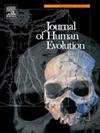髋臼方向、骨盆形状与人类两足行走的进化
IF 3.1
1区 地球科学
Q1 ANTHROPOLOGY
引用次数: 0
摘要
古人类的骨盆形状与其他灵长类动物有很大的不同,它有更侧向的髂骨、更宽的骶骨和更大的横向宽阔的骨盆入口。髋臼的方向也可能不同,这可能与直立姿势和习惯性双足运动时负荷传递的差异有关,这可能反过来影响骨盆的整体几何形状。我们比较了人类(现存类人猿灵长类的系统发育广泛样本)和古人类化石(包括阿法南方古猿(A.L. 288-1, KSD-VP-1/1)、非洲南方古猿(Sts 14)、南方古猿sediba (MH2)、和尼安德特人(Kebara 2)。我们通过将模型注册到关节骨盆上的地标坐标,在与中平面对齐的单个髋骨的计算机模型上测量了髋臼的三维方向。与现存的类人猿相比,人类和古人类的髋臼都具有更大的腹侧开口,后者的髋臼面向外侧。至少在3.6 Ma之前,古人类髋臼的方向基本上与人类相似,远远早于人类骨盆中其他独特特征的出现,这些特征可能与该属的长距离行走或跑步、体温调节、分娩和更大的体型有关。这些结果表明,髋臼的腹侧方向是与古人类习惯性两足行走相关的一系列盆腔特征的关键组成部分,应该在未来的古人类盆腔形态分析中加以考虑。本文章由计算机程序翻译,如有差异,请以英文原文为准。
Acetabular orientation, pelvic shape, and the evolution of hominin bipedality
Hominin pelvic form differs dramatically from that of other primates by having more laterally facing iliac blades, a wider sacrum, and a larger, transversely broad pelvic inlet. The orientation of the acetabulum may also differ, plausibly related to differences in load transmission during upright posture and habitual bipedal locomotion, which may, in turn, affect overall pelvic geometry. We compared acetabular orientation in humans, a phylogenetically broad sample of extant anthropoid primates, and fossil hominins including Australopithecus afarensis (A.L. 288–1, KSD-VP-1/1), Australopithecus africanus (Sts 14), Australopithecus sediba (MH2), and Homo neanderthalensis (Kebara 2). We measured the three-dimensional orientation of the acetabulum on in silico models of individual hipbones aligned to the median plane by registering models to landmark coordinates on articulated pelves. Humans and fossil hominins both possess significantly more ventrally opening acetabula than other extant anthropoids, which exhibit laterally facing acetabula. The orientation of the hominin acetabulum was essentially humanlike by at least 3.6 Ma, well before the appearance of other unique features in the pelvis of Homo that may be associated with long-distance walking or running, thermoregulation, parturition, and larger body size in this genus. These results suggest that the ventral orientation of the acetabulum is a key component in the suite of pelvic characteristics related to habitual bipedality in hominins and should be considered in future analyses of hominin pelvic morphology.
求助全文
通过发布文献求助,成功后即可免费获取论文全文。
去求助
来源期刊

Journal of Human Evolution
生物-进化生物学
CiteScore
6.30
自引率
15.60%
发文量
104
审稿时长
3 months
期刊介绍:
The Journal of Human Evolution concentrates on publishing the highest quality papers covering all aspects of human evolution. The central focus is aimed jointly at paleoanthropological work, covering human and primate fossils, and at comparative studies of living species, including both morphological and molecular evidence. These include descriptions of new discoveries, interpretative analyses of new and previously described material, and assessments of the phylogeny and paleobiology of primate species. Submissions should address issues and questions of broad interest in paleoanthropology.
 求助内容:
求助内容: 应助结果提醒方式:
应助结果提醒方式:


